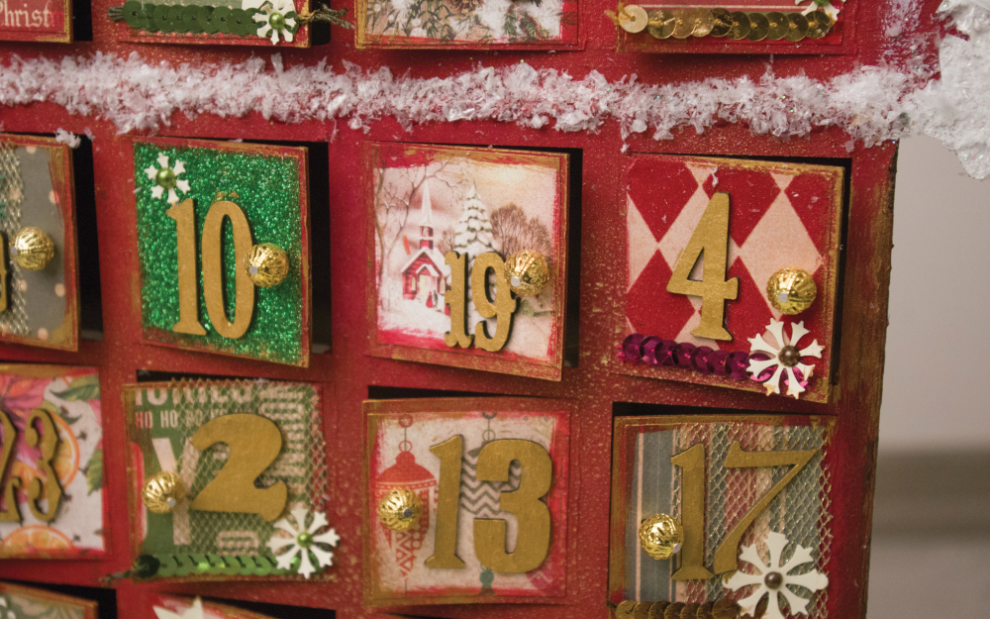The Advent calendar is one of the few traditions from my Catholic childhood that really took root in my own children’s lives. The Jesse Tree, which I had loved in Catholic school, flopped with my kids—too pedantic for their tastes—and I almost always forget to order purple and pink candles in time for an Advent wreath. But we usually have a few calendars going simultaneously to count the days until Christmas. My daughter likes Advent calendars with chocolates, while my son prefers to assemble the wintry scene that comes with the Lego Star Wars calendar. For my personal use, I always look for the kind of Advent calendar that resembles an ornate Victorian manse with doors and windows you pry open to reveal the goings on inside.
I feel a little thrill of mystery before opening each little portal of the Advent calendar to see what is happening on the other side. Behind door number one, a child drinks hot chocolate by the fire. Behind door number two, Grandma sews a Christmas stocking. Behind door number three, Mom wraps a gift. I find myself searching the tiny images for minuscule details that delight me: a mouse peeking out of a hole in the floorboard or a kitten napping on the rug. Some Advent calendars might show bits of the nativity story—a heavily pregnant Mary on a donkey, for example—but I am just as enchanted when I find the workings of an ordinary household. I don’t need explicit religious iconography to feel prompted to wonder. It isn’t really the picture that provides the sense of joyful mystery anyway; it’s the opening of the door itself.
The anticipation of Advent
One of my favorite photographs by the artist Shannon Taggart, included in her collection Séance (Atelier), captures a similar sense of anticipation and wonder. For years, Taggart traveled the world photographing Spiritualists, who believe we can communicate with the spirits of the dead through mediumship. In the image I’m thinking of, two mediums are backstage at the Lilydale Assembly in New York, the largest Spiritualist community in the world. They are about to go on stage, where they will receive a message from the spirits to convey to the audience, something that happens multiple times a day during the summer months when the community is open to guests for a small fee.
In the photograph, the two mediums are leaning toward the stage door expectantly. Through that open door, we see the stage, theatrically lit, occupied by two partially visible empty chairs. On the other side of the stage is another door, slightly ajar, with only shadows visible beyond. The moment is pregnant with expectation. Something is about to happen. No, something is already happening. The photo is like a held breath. Everything depends on the opened door.
Every photograph is a kind of opened doorway, framing what already exists. Philosopher J. F. Martel, author of Reclaiming Art in the Age of Artifice (North Atlantic), pointed out in an interview with Taggart that the moment you put a frame around something, you immediately elevate it. Every object within the frame takes on a vitality that almost certainly would have otherwise gone unrecognized. In Taggart’s photo of the mediums, for example, a single umbrella hangs on an otherwise empty coat rack. She said she didn’t notice the umbrella at all until she developed the photo, but then it seemed essential. Everything within a frame is revealed to be necessary to the ongoing story, kind of like the little vignettes behind the doors of my Advent calendar.
Doors as liminal spaces
In the ancient world, dozens of gods presided over doorways, gates, and portals, including the Roman god Janus, deity of transitions and liminal spaces, who gives his name to the first month of the calendar year. The psychologist Carl Jung, who was fond of the door as an archetypal motif, spoke of the shadow self as the door to the world of the soul. The inscription over the door of Jung’s family home in Zurich reads vocatus atque non vocatus deus aderit. Roughly translated, it means: Called or not, God will be there. The same phrase was also on Jung’s grave. I suppose he wanted a reminder, at all his comings and goings, that no matter what door we walk through, God is already there. As Jesus put it in Revelation 3:20: “Listen! I am standing at the door, knocking; if you hear my voice and open the door, I will come in and eat with you, and you with me.”
Studying Taggart’s photograph, my mind wanders between these associations and the mini-portals of my Advent calendars. I realize Jesus not only stands at the door, waiting for us to hear his voice and open it; he also is the door (John 10:9).
In the Gospel of John, in the same passage where Jesus self-identifies as a door, he describes himself as the Good Shepherd. Most of us are familiar with this comforting image of protection from icons, statues, and children’s catechesis. I find it fascinating, however, that Jesus puts just as much emphasis on his identity as the door or the gate. This image of Jesus is a reminder that we may come and go, into the safety of the fold and out into the pastures, without fear of destruction.
Jesus the Door
As someone who has come to terms with being on the church’s margins, I find Jesus the Door vital to my understanding of my spiritual life. When my curiosity and my artistic practice take me into ever stranger territories, I remember: Called or not, God is there. The door is both the portal through which I pass and the frame that helps me see my experience in its proper context. This imagery reminds me that the church’s walls do not segregate Jesus from people, experiences, and ideas found on the margins. Jesus is there on the threshold—and Jesus waits on the other side of the door as well.
Going back to my analogy to photography: When I look at the world through the “frame” of Jesus, everything I see takes on new meaning. This is the frame that helps me to understand all I encounter, both inside and outside the church, allowing me to measure it against the truth of Christ. When this region I inhabit out here on the margins becomes lonely or my relation to my community uncertain, I remember I have a portal to the divine that is always already present, awaiting my discovery.
The season of Advent is a season for waiting, often in uncertainty, in shadowy and liminal spaces. And in this season, we are encouraged to open a door again and again—on most Advent calendars, at least 24 times until Christmas Day—looking for what is already there but possibly obscured by the detritus of daily life. We wait for a God who is here, right now, but at the same time, we must pass through the door to encounter what we cannot yet see, though it too is already happening: the realm of heaven, which Jesus says is right here, nearby, “at hand” (Mark 1:15). God is what we seek—and God is the way we find it.
My children will probably discover, as they get older, that the treats and toys in their Advent calendars lose their magic. That is part of growing up, in life and in faith: We realize the physical world cannot fully satisfy, and we shift our attention to the wonder of the invisible world. But I hope my kids come to appreciate the pleasure of simply opening an Advent calendar’s tiny doors. That sense of mystery and surprise, the knowledge that we are about to peek through a portal into something hidden—that was the real source of the magic all along.
This article also appears in the December 2023 issue of U.S. Catholic (Vol. 88, No. 12, pages 45-46). Click here to subscribe to the magazine.
Image: Unsplash/Elena Mozhvilo














Add comment